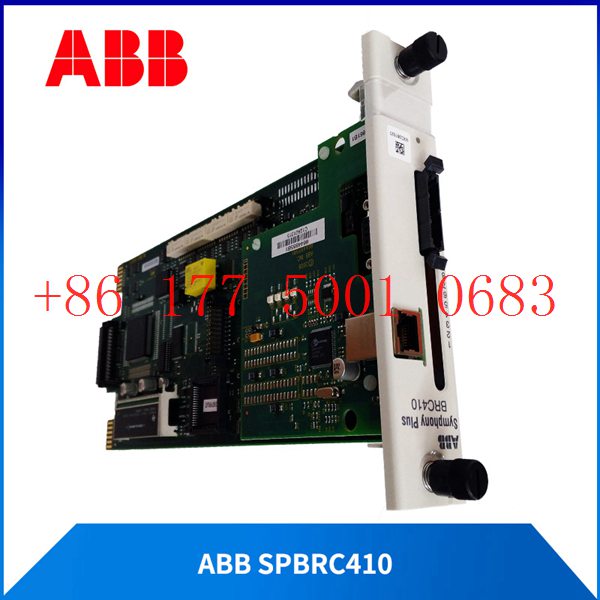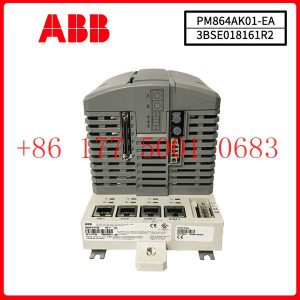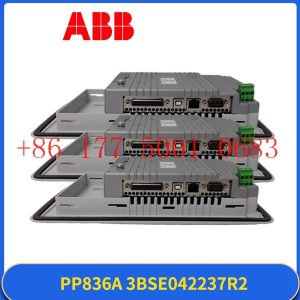Description
hardware flow control. It is an ideal choice in the field of industrial automation.
Although it was established only a few months ago, ABB Future Lab has already cooperated with Huawei to
complete the AI training of garbage sorting robots in two months. This robot uses AI technology based on Huawei
chips and uses industrial cameras to sort objects.
Obviously, adjusting the business model and organizational structure is an important reason why ABB has
lways been at the forefront of the industry.
From technology iteration to application implementation, ABB aims to provide complete solutions
As a pioneer in manufacturing automation and digitalization, ABB”s products in the automation field are constantly
improving, and its application industries are also expanding.
In Alf”s view, the structure and construction of automation have not changed much in the past 30 years. From signal
collection and information transmission to work scenarios or operational interfaces, the flow of information in automated systems has basically not changed.
But the arrival of 5G may change the way information is transmitted between devices. 5G’s characteristics such as large
capacity, high reliability and low latency make it possible to realize independent connections between devices. If real-time
mainline connection can be achieved and installed on the cloud or platform, it will be a more disruptive application.
5G will not only change the way ABB operates, but is also likely to introduce digitalization into the industry, including digital
operation and maintenance. ABB has launched an industrial Internet solution called ABB Ability, which firstly provides a platform
, and secondly, it includes all ABB”s digital cloud products, such as equipment industrial solutions and transportation solutions.
In addition to digitization, another focus of Alf is the autonomy of machines. He took the autonomous management of
autonomous driving and warehousing as examples to think about the development process of machine autonomy –
from human operation to machine operation, and ultimately to autonomous implementation and testing without the need for humans at all.
For ABB, in addition to popular autonomous driving technology, industrial production scenarios also have strong
demand for the autonomy of machinery and equipment, such as autonomous docking of ships and the mining industry
. In some industrial scenarios represented by mining, toxic gases and substances in the working environment are
harmful to the human body, so equipment
is required to have the ability to enter and leave the mine independently. ABB first needs to study the value proposition
of these businesses, discover potential applications, and then discover in which fields it can be applied.
A technology close to autonomy is artificial intelligence. Since its birth in the 1960s, it has been attracting people”s
attention, and there have been endless discussions about “robot replacement”. After decades of development,
related technologies have gradually matured, and more and more AI technologies have begun to be discussed
in the application field. The products and technologies
of leading manufacturers such as ABB have attracted much attention.
ABB has been applying AI technology to its products for 20 years, but its current mature products are mainly
diagnostic applications based on traditional statistics. Alf introduced to Yiou New Manufacturing that
as part of the diagnostic solution, this technology is mainly used to implement condition monitoring functions
. More mature applications are reflected in the automated management of equipment, such as the electronic
management of ships.
Machine learning is another promising AI technology. At the World Artificial Intelligence Conference at the
end of August this year, ABB demonstrated a coffee workbench composed of a two-arm collaborative robot Yu Mi.
Through guided programming of YuMi, the collaborative robot can learn and
remember the barista”s movements to complete the complete process of making coffee, latte art and delivering it to the audience.
In actual implementation scenarios, this technology is used to transform terminals carrying containers. By simulating the
location and status of box handling, the collected data is used to train the AI, allowing the AI to know the
location of the container, thereby achieving automation.
From automation, digitalization, autonomy and artificial intelligence technologies, ABB is not a blind pursuer of
emerging technology concepts. It pays more attention to customer needs and actual implementation, and achieves
better solutions through different product combinations.
There are two major difficulties in balancing R&D and business and implementing solutions.
As a commercial company, ABB still needs to consider the balance between R&D investment and revenue.
In Alf”s view, they do not have unlimited R&D resources, so they need to focus on finding a balance between
improving original product functions and developing new functions. In terms of technology research and development,
we also need to try to focus on projects that can bring the greatest value to the company.
Regarding the specific implementation of digital solutions, Alf believes that there are currently two main difficulties.
The first difficulty is that ABB cannot just develop a general solution, because different industry segments
have different needs, so it must design solutions that suit their different needs. ABB not only needs to master
knowledge in different fields and different applications, but also needs to consider the availability of data.
The second difficulty lies in the use of data, because AI requires a large amount of data training. On
the one hand, ABB needs to encourage customers to provide data for training models; on the other hand,
ABB also needs to ensure customers the privacy, ownership and security of their data.
“Industrial artificial intelligence needs to be combined with models and data. But the most
important thing is that we must provide value to customers through the use of AI, otherwise we will just
apply technology for the sake of applying technology.” Alf concluded.
GE RXE2N0Q0J132A R2E0N1A0A1T0A
KOLLMORGEN 3YL-24
KEI 3240D81A
KC REMOTE MONITOR PANEL FOR ICCP SYSTEM
JUNG-A SERIES-JAWSVS-801 WIPER-MOTOR CONTROLLER
JUNG-A SERIES-JACMS-500 CVS-MOTOR CONTROLLER
JUMHO ELECTRIC L1200
HWASAN PMU-24D
HATLAPA BCS-03-PART-316547-04702
DANIAMANT SL8005 VER-1A
DAMCOS DANFOSS IPH MARINE MAS PD 3221 UPI TACHO UNIT
DAEHO FLOW INSTRUMENTS VC-30
CONSILIUM MARINE KVC-413
CMC INSTRUMENTS ZOA-100
BERG P4504-S0060
BEIJER ELECTRONICS X2PRO7-B2
BEIJER ELECTRONICS X2PRO4-B2
BC COMPONENTS 15000UF-UR40V-222215417153
AUTRONICA GT302A3CO
AMCO AMC-48 AMCO-NETWORK S-UNIT
ABB RVG200 SCREENMASTER
ABB NDBU-95C-9CH DDCS
TELEFRANG AB S48 8-16 AIN + 2 AOUT SIOX
TELEFRANG AB S45 SIOX
TELEFRANG AB S27 SIOX
VM600 204-040-100-012
VM600 IOCN 200-566-000-112 200-566-101-013
VM600 RLC16 200-570-000-111 200-570-101-015
VM600 IOC4T 200-560-000-111 200-560-101-017
VM600 IOC16T 200-565-000-013 200-565-101-013
VM600 RPS6U 200-582-600-013
VM600 CMC16 200-530-025-014 200-530-111-013
VM600 MPC4 200-510-071-113 200-510-111-034
VIBRO-METER VM600 CPUM 200-595-067-114
KONGSBERG NORCONTROL DPU4-RAi-10tc-8100161-HA451673A
KONGSBERG NORCONTROL RAi-16-8100148-HA451671A2 REV-E2
KAMEWA ANALOG CARD-4
HBM CLIP-AE-301
CEGELEC MAE96-11-4CHANNEL-ISOLATED-ANALOG IO TERMINATION PANEL
ALSTOM MAE 00-14-4CH-ANALOG IP TERMINATION PANEL
CMR MS.C2u Amplifier
EMERSON MAS-2600 TRANSDUCER AMPLIFIER PCB
GAI-TRONICS 701-302
GAI-TRONICS 723-001
HANSHIN PMA-9400
JUMO TT454 ISOLATION AMPLIFIER
KNICK B-13000 F1
KNICK VARITRANS P-15000-H1
PHOENIX CONTACT MINI MCR-SL-UI-UI-SP
PHONTECH INTERM 1594 PA-9324
PHONTECH INTERM PA-9336
REXROTH A27920 VT-MSPA-2-525-10-V0 MNR-0811405106
ROLLS-ROYCE SPA-1-7351928-001
VODEC AMPLIFIER C-VA300 AMP CAGE TYPE C VPR010ZH AMPLIFIER CABINET
Watlow Anafaze CLS200 Controller 2040-6511
Watlow Anafaze CLS200 Controller 2040-6522
Watlow Anafaze CLS200 Controller 2040-6554









Reviews
There are no reviews yet.